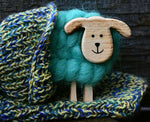*** Free UK shipping on orders over £75 ***
*** Free UK shipping on orders over £75 ***
Hooks & Needles
Bags & Kits
Accessories
What Is Merino Wool?
June 07, 2022 5 min read

Contents
- Where does merino wool come from and what is it made from?
- What are the main benefits of merino wool?
- What ply is merino wool yarn?
- How to wash merino wool socks and other garments
- Who are the best suppliers of merino wool?
Where does merino wool come from and what is it made from?
The merino sheep is one of the oldest breeds of sheep in the world. Originally hailing from the Atlas Mountains in North Africa, in the Middle Ages these beasts reached Spain. From there, their wool became a sensation across Europe.The merino sheep evolved to survive in extreme weather conditions. High in the mountains, the seasons can be very different, with a freezing winter, wet spring, and hot summer. As such, the merino sheep developed a fleece that could handle all kinds of temperatures and withstand the rain. Their unique, remarkable wool is prized around the world for its special qualities.
Where does merino wool come from nowadays? Today, merino sheep can be found all over the globe, in wool-producing countries and regions such as South America, New Zealand, and South Africa. However, the country that produces the most merino is Australia. Merino sheep thrive in adverse weather, and the harsh Australian climate is particularly good for their development.
It's worth noting, though, that while most merino wool comes from Australia, it is usually exported as a raw fleece. It is then spun into yarn in different countries, sometimes on a large industrial scale, and sometimes as part of a cottage industry. Finally, this high-quality yarn reaches the shops for knitters to use and enjoy. It's not just used for knitting, either - its fabulous qualities mean that it's often turned into sporting garments for hikers and trail runners.

What are the main benefits of merino wool?
If you hold a ball of merino wool in one hand and a ball of standard wool in the other, you're sure to feel a difference. Because its fibre is smoother, merino is softer to the touch, with far less itchiness. This makes it more suitable to be worn against the skin, as it's less likely to irritate. The fibre is also longer than most wool fibres, which means that pilling is less of a problem. As a result, garments knitted from merino will generally look better for longer.Is merino wool warm? Yes! Merino is a soft, bouncy fibre that provides warmth without much weight. Handknitted garments can often be heavier than their commercial equivalents, but a merino jumper will generally be a lot lighter than one knitted from standard wool. As such, many people find merino more comfortable to wear.
Importantly, merino stays warm even when it's wet, and has moisture-wicking properties. This makes it a particularly popular choice for sock yarn. No need to worry about sweaty feet - the merino will gently wick the liquid away, leaving your feet warm, dry, and cosy!
What ply is merino wool yarn?
Merino is a fibre rather than a specific weight of yarn, so it is available in every different ply. The ply that you choose will depend on the project you have in mind.If you plan to make merino socks, look for 4 ply or sock yarn. This will usually be a blend of merino and nylon, generally in a ratio of 75% merino, 25% nylon. The reason for this blend is to ensure your socks last longer. The nylon adds elasticity and durability, particularly in the toe and heel, where socks often wear out quickly.
Merino is very suitable for baby clothes, as it is a lot softer and lighter than regular wool. Babies have sensitive, delicate skin, and they usually find wool scratchy, so merino is a very sensible choice. If you are knitting for a baby, look for a lighter yarn, such as 4 ply or sport weight. This will help keep the garment comfortable.
For adult garments such as jumpers or cardigans, you can in theory use any ply of merino yarn. Most patterns tend to be written for DK or worsted / aran. Thicker yarn, such as chunky, will knit up faster but you'll have a heavier garment. Thinner yarn looks great knit into a jumper, but expect the knitting to take a very long time!
How to wash merino wool socks and other garments
You should take care when washing merino wool. Heat and agitation, like you'll have in a regular washing machine cycle, will cause the wool to felt. In rare cases, you might want this, if your knitting project needs to be felted. However, accidental felting should be avoided at all costs, as it's the quickest way to destroy all your hard work.To keep your garment from felting, always wash it with cool water. Some knitters wash their merino wool projects in the machine, set on a gentle cycle. If you're nervous about trying this, it's a good idea to wash your gauge swatch first, to see how it reacts. You can also handwash merino wool, using cool water and a wool wash product. Don't dry clean merino garments, as the chemicals used will cause the wool to stiffen and lose its characteristic softness.
If you think that washing your garments will give you a headache, the easiest option is to find superwash merino wool. This has been treated to stop it from felting. Almost all merino sock yarn is superwash, as few knitters want to spend time handwashing their socks! If you're knitting for a baby, look for superwash merino wool as it will be far more convenient.
However you wash your merino, take care when drying it. Never put it in the tumble dryer. If your garment looks like it has lost its shape in the wash, you can gently reshape it before leaving it to dry flat. Hanging wet wool garments can cause them to stretch out of shape.
Merino Wool Suppliers
- Emma's Yarn is based in Florida, and produces exquisite hand dyed yarns in a range of stunning colours. Some of their most popular merino products include gorgeous sock yarns. They also make blends of merino and silk; soft and drapey, these are ideal for statement pieces like shawls.
- Irish Artisan Yarns makes gorgeous hand dyed yarns at its base in Ireland. These yarns often use unusual fibres. Their blend of merino, bamboo, and silk is incredibly soft to the touch and drapes beautifully. Use it for delicate projects like scarves and cowls.
- Black Elephant Yarn is based in the UK and makes magnificent merino sock yarn. Choose a solid colourway to make socks with a lace design, or go for a simple pattern and one of Black Elephant's wild colour palettes for the funkiest socks in town!
- Spectrum Fibre is another great producer of merino sock yarns. Their yarn has a twist to it, which gives excellent stitch definition. Use it for patterns where you want to show off techniques such as cables, slipped stitches, or brioche, as with this yarn, your stitches will really stand out.
Also in Yarn Guides

How to crochet a magic circle
May 19, 2023 4 min read

Crochet Tools and Accessories Guide
January 27, 2023 5 min read

How to Block Knitting
October 10, 2022 5 min read

Join our email newsletter
Be the first to know of new product releases and other exciting news!

